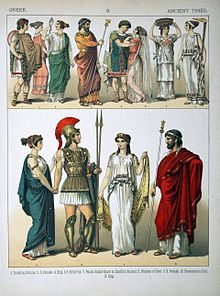Costume History/Greek
Greek Costume Design
[edit | edit source]Types Of Clothing
[edit | edit source]
Peplos- The peplos was a made of a large square piece of cloth. The cloth was folded double on the upper body, and the entire piece of cloth was folded around the body, and fastened over each shoulder. The ionic or laconic peplos was open on the side of the body, while the Doric peplos was sewn shut like a tube. Usually a belt was worn over the peplos. In Greece the peplos was mostly worn before the 5th century BC.
Chiton- the chiton was a large square of cloth. During the Doric era the cloth was folded and then wrapped around the body then held in place with pins. During the Ionic era the cloth was first sewn into a tube. Both eras used bets around the waist.
Himation- the himation was a large piece of cloth that was placed over the left shoulder and around the back then under the right arm. The cloth usually reached the knees but could be longer, and it was usually very heavy and used as a cloak against cold weather.
Chlamys- the chlamys was a shorter version of the himation worn only by men and soldiers.
Colors- contrary to popular belief Greek clothing came in many different colors and shades not cream or white.
Women
[edit | edit source]
Women would wear any of these items except the chlamys. They also wore cosmetics. Using ashes as eye shadow, white lead was used to make skin paler, the juice of the alkanet root was used like rouge, they even used lipstick. Perfume was also very important. Hair was styled to show marital status and held in stylized locks by diadems or headbands.
Men
[edit | edit source]Men, in general, wore simpler clothing than women. They did not wear the peplos and their chiton was shorter and only wrapped around one shoulder.
Shoes
[edit | edit source]At home the Greeks generally went bare foot but in public they would strap a piece of leather to their foot to make a sort of sandal.
Accessories
[edit | edit source]Jewelry was seen as a form of art to wear and had no class standing but was limited by what one could afford. It was also used as offering to the gods and was sometimes buried with the dead.
Time Periods
[edit | edit source]There were three main time periods during ancient Greece; the Doric era which took place in the sixth century BC, Ionic in the Fifth, and Hellenistic during the Fourth. Doric and ionic set the stage for Greek fashion while Hellenistic was the time during which Greek culture was at its peak.
Gallery
[edit | edit source]-
Ancient Macedonian mosaic depicting a lion hunt. Alexander the Great wears a kausia on his head and both hunters wear kausia.





